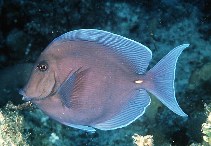| Family: |
Acanthuridae (Surgeonfishes, tangs, unicornfishes), subfamily: Acanthurinae |
| Max. size: |
39 cm TL (male/unsexed) |
| Environment: |
reef-associated; marine; depth range 2 - 50 m |
| Distribution: |
Western Atlantic: New York, USA and Bermuda to the Gulf of Mexico and Brazil. Eastern Atlantic: Ascension Island (Ref. 7345). |
| Diagnosis: |
Dorsal spines (total): 9-9; Dorsal soft rays (total): 26-28; Anal spines: 3-3; Anal soft rays: 24-26. A deep-bodied surgeonfish (body depth 1.7 in SL) with a conspicuous yellow caudal spine. Has the most distinctive coloration of all western Atlantic surgeonfishes (Ref. 26938). |
| Biology: |
Inhabits coral reefs, inshore grassy or rocky areas. Forms small groups (Ref. 26235). Mainly diurnal. Feeds entirely on algae (Ref. 5521). At Fernando de Noronha Archipelago in southwestern Atlantic, juveniles hold cleaning stations together with the doctorfish (Acanthurus chirurgus) and sergeant major (Abudefduf saxatilis) and graze algae as well as pick molted skin and parasites from green turtles (Chelonia mydas). This behavior is preceded by a characteristic inspection usually followed by feeding nips on the turtles’ skin (head, limbs, and tail), as well as on the carapace. The most inspected and cleaned body parts are the flippers (Ref. 51385). Diurnal species (Ref. 3194). It forms resident spawning aggregations in late afternoon after high tide (Ref. 27825, 120681, 120682). The spine on both sides of the caudal peduncle may inflict painful wounds (Ref. 5217). Marketed fresh. Maximum depth reported taken from Ref. 127989. |
| IUCN Red List Status: |
Least Concern (LC); Date assessed: 03 May 2010 Ref. (130435)
|
| Threat to humans: |
traumatogenic |
Source and more info: www.fishbase.org. For personal, classroom, and other internal use only. Not for publication.

